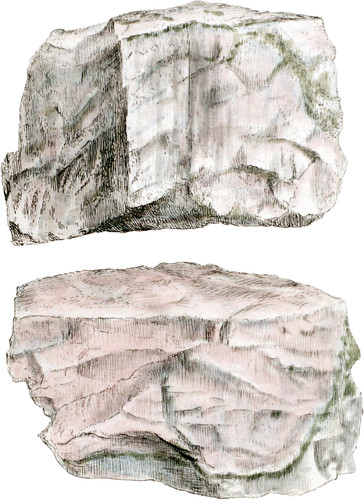 Enlarge
Enlarge
Exotic Mineralogy
Petalite
- Syn.
- Petalitte? D’Andrada, Journal de Physique 51, 244.
- Berzelite. Clarke in Annals of Philosophy XI. 365.
Mr. D’Andrada gave an account of a new mineral in the 51st volume of the Journal de Physique, to which he gave the name Petalitte:* this mineral remained unknown to English mineralogists until Mr. Swedenstierna sent a considerable quantity of a substance, much resembling rose Quartz, to London, under that name. Mr. Swedenstierna also sent it to Dr. Ingle, at Cambridge, where it was analyzed by Professor E. D. Clarke and the Rev. Mr. Holme, and found to be sufficiently distinct from Quartz. Dr. E. D. Clarke, however, doubts whether it be really the Petalitte of D’Andrada, and wishes to call it Berzelite. At present we must abide by the authority of the Swedish mineralogist. The eye may distinguish it from Quartz by its inferior lustre; by the uneven appearance of the cross fracture, and by a tendency to divide in certain directions, with flat spining faces, that may be readily discovered. These divisions, according to Dr. E. D. Clarke, are parallel to the sides of a rhomboidal prism, whose obtuse angle equals 100°. My specimen exposes surfaces of lamina:, parallel to a four-sided prism of about 86 and 94°; these surfaces are equally shining, but not very bright; they are a little Curved, which may cause them to give a different measure from that assigned by Dr. Clarke. Fractures are also visible in several parts in the direction of the long diagonal of the base of this prism; they produce surfaces of considerable brilliancy, but of less extent than those of the prism, upon which they are equally inclined. Dr. Clarke found the specific gravity of a nearly white specimen to be 2.45.: he also found that by a long continuance of an intense heat from a blow-pipe, the surface was glazed, and became full of minute bubbles. The colour varies from white to a pale rose colour; the whiter varieties have often a tinge of grey: when breathed upon it emits a peculiar odour, less suffocating than that of argillacious Limestone. It is found accompanying Spodumen, Quartz, Mica, &c.
The analysis by Mr. Arfrcdsou, a pupil of Berzelius’s, has afforded one of the most extraordinary results obtained for some years; it has proved the existence of an alkali before unknown, which resembles Soda in some respects; but its salts differ in many properties from those of either of the fixed alkalies, particularly in their easy fusibility. This alkali has received from its discoverer the appellation Lithion, or, Lithina, to denote its origin in the mineral kingdom.
| Analysis by Arfredson.† | By Clark.‡ | By Holm.‡ | |
|---|---|---|---|
| Silica | 80 | 80 | 768/16 |
| Alumina | 17 | 15 | 208/16 |
| Lithina | 3 | ||
| Manganese | 2.50 | 28/16 | |
| Water | 0.75 | 010/16 | |
| Loss | 1.75 | 0 | |
| 100 | 100.00 | 1002/16 | |
- * M. D’Andrada’s description does not precisely agree with the mineral before us, which can hardly be called, “en masses qui sont des ; réunions de pièces separées, grenucs;” neither is its spec. grav. above 2.620.
- † Annals of Philosophy, Vol. 11. p. 291.
- ‡ Ib. Vol. II. p. 198.

